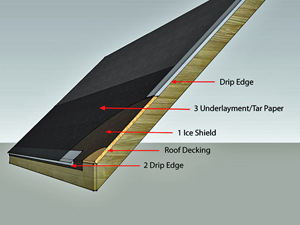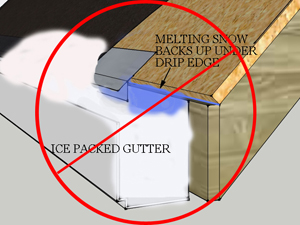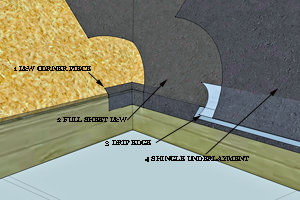
Ice Shield (ice guard)
- Category: Ice Dams
- Written by Administrator
How to install ice and water shield to stop ice dam leaks. 
Ice and water shield, ice guard, water proof underlayment, self stick underlayment.
These are all terms for a rubberized asphalt sheet membrane intended to prevent water from ice dams penetrating your roof envelope and leaking into your house. Generally speaking, these materials perform as intended. When they fail, it's usually from improper installation.
Get it Right
Proper installation means that the membrane is adhered directly to the lower edge of the roof decking, and, more importantly, draped over the edge of the roof and adhered to the fascia or gutter board. Before any tar paper, roofing, drip edge, apron or rain gutter is installed.
Installing the ice shield after the drip edge has been installed, as some manufacturers and contractors suggest, will allow water from ice dams to back up under the drip edge and leak into the gap between the roof decking and the fascia board.

Attention to Detail
Proper atttention to details will ensure a leak free installation.
Make sure the roof surface and gutter board are free of dust and debris.
Make sure the ice shield membrane is free of wrinkles.

Types of Ice Shield
There are a few types of ice guard to be aware of.
High temperature ice guard is intended to be used under roofing materials like metal and slate that tend to absorb the heat from the sun. When ice guard was first introduced there was only one formulation for roofing. Although it held up well under asphalt shingles, the additional heat from slate and metal roofing caused the ice shield to melt and ooze out from beneath the roof materials.
Standard grade ice shield is intended for the lower edge of the roof that takes the brunt of damage from ice dams. It is thicker and will seal better around roofing nails.
Lighter grade ice shield is used by some as a whole house underlayment. Or around flashings and roof penetrations.


